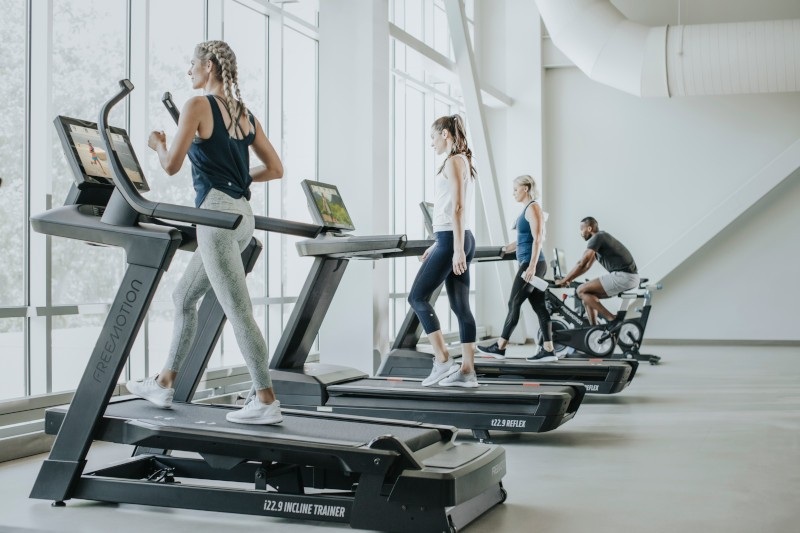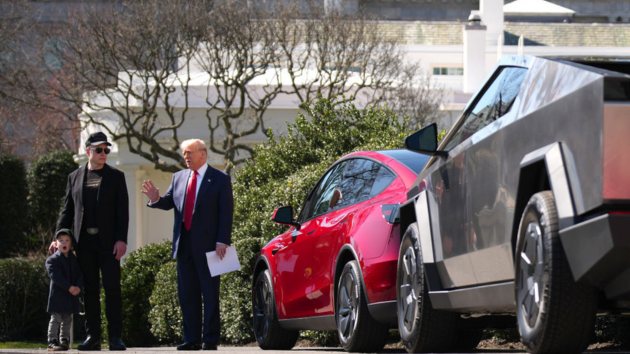
Andrew Harnik/Getty Images
(WASHINGTON) — President Donald Trump has disrupted global trade and roiled markets in an effort to bring manufacturing jobs back to the U.S. Some of his top tech allies, however, have backed ventures that replace human workers with robots.
Elon Musk, a top donor and adviser to Trump, has touted humanoid robots as a future growth area for electric-carmaker Tesla. “You can produce any product,” Musk said of the robots’ potential capacity during a February interview with Dubai’s World Governments Summit.
Amazon founder Jeff Bezos, who Trump last month called “terrific,” has invested in several advanced robotics firms.
Bezos last year poured funds into Figure, a humanoid robot company that says its initial rollout will focus on manufacturers and warehouses, among other business applications. “We believe humanoids will revolutionize a variety of industries,” the company says on its website.
Nvidia CEO Jensen Huang and OpenAI CEO Sam Altman – both of whom joined Trump on his recent trip to the Middle East – helmed their respective companies as each invested in Figure. OpenAI ended its partnership with Figure last year.
“Trump is talking about bringing back the jobs, and he’s not understanding the tension between that goal and automation, which the tech bros have enthusiasm for,” Harry Holzer, a professor of public policy at Georgetown University and a former chief economist at the U.S. Department of Labor, told ABC News. “There’s a fundamental conflict between those goals.”
Musk did not immediately respond to ABC News’ request for comment made through Musk-owned firm SpaceX. Neither Bezos, Huang nor Altman responded to ABC News’ request.
Speaking at a conference in April, Huang said the onset of artificial intelligence would fuel “new types of factories,” which in turn would create jobs in construction and steelmaking, as well as in trades such as plumbing and electricity.
Even more, Huang said, AI is set to trigger a surge in productivity at companies that adopt the new technology, allowing them to add employees as the firms increase output and revenue.
“New jobs will be created, some jobs will be lost, every job will be changed,” Huang said. “Remember, it’s not AI that’s going to take your job. It’s not AI that’s going to destroy your company. It’s the company and the person who uses AI that’s going to take your job. And so that’s something to internalize.”
Even after a rollback of some levies, consumers face the highest overall average effective tariff rate since 1934, the Yale Budget Lab found earlier this month.
A key reason for the tariffs, White House officials say: Reshoring factories and rejuvenating employment in the manufacturing industry.
Commerce Secretary Howard Lutnick said this month in an interview with Fox News that Trump’s vision for ushering in a “golden age” for America involved enticing manufacturers to open factories and build in the United States.
“We’re going to have huge jobs in manufacturing. You’ve heard the president talk about trillions and trillions of factories being built in America,” he said in the interview on May 11.
In response to ABC News’ request for comment, White House Spokesperson Kush Desai said “the importance of President Trump’s push to reinvigorate American industry goes beyond creating good-paying jobs for everyday Americans.”
“Supply chain shocks of critical pharmaceuticals, medical equipment, and semiconductors during the COVID era prove that America cannot rely on foreign imports. The Trump administration remains committed to reshoring manufacturing that’s critical to our national and economic security with a multifaceted approach of tariffs, tax cuts, rapid deregulation, and domestic energy production,” Desai added.
The share of U.S. workers in manufacturing has plummeted for decades. Roughly 8% of U.S. workers currently hold positions in manufacturing, which marks a steep decline from about a quarter of all employees as recently as 1970.
Researchers attribute such decline to overlapping trends, including the offshoring of manufacturing to low-wage markets overseas and the adoption of labor-saving technology throughout the sector.
Long before current advances, automation significantly increased productivity in U.S. factories, meaning the same number of workers could produce many more goods, researchers at Ball State University found in 2015. As a result, they said, manufacturing employment stagnated for decades even as output climbed.
“Automation is something we’ve seen for a long time,” Philipp Kircher, a professor of industrial and labor relations at Cornell University, told ABC News.
Some of Trump’s tech allies have backed firms that seek to further automate manufacturing, touting a new wave of artificial-intelligence equipped robots as a replacement for some workers and salve for labor shortages.
Robotics outfit Vicarious boasts $250 million in investments from a set of backers that includes Bezos, Musk and Meta CEO Mark Zuckerberg – all of whom flanked Trump during his inauguration.
On a webpage displaying photos of robots for use in warehouse settings, Vicarious tells potential clients that the products can “reduce both your costs and person-hour needs.”
In 2022, Vicarious was acquired by Alphabet-backed robotics software firm Intrinsic. Alphabet CEO Sundar Pichai also sat alongside tech leaders at Trump’s inauguration.
Alphabet did not respond to ABC News’ request for comment. Meta declined to comment.
Yong Suk Lee, a professor of economics and technology at the University of Notre Dame, described the views on automation among Trump’s tech allies and some of his trade advisers as “opposed.”
The tech position, Lee said, would likely win out, even if some firms do open plants in the U.S.
“If you want to reshore, are you going to pay the same wages as Vietnam? Probably not,” Lee said. “Companies are faced with higher labor costs. In that case, they’ll probably automate.”
Discordant views among some tech leaders and White House officials surfaced in April, when Musk sharply criticized tariff-advocate Peter Navarro, Trump’s senior counselor for trade and manufacturing. Navarro, Musk said, is “truly a moron.”
In an interview with CNBC, Navarro responded, saying Musk “isn’t a car manufacturer — he’s a car assembler.”
To be sure, analysts said, automation in manufacturing would likely continue regardless of support from Trump’s tech allies, since producers are locked in a competition to lower costs and increase output. The precise outlook for manufacturing employment is unclear, they added, since additional technology may add jobs for those maintaining and optimizing the machinery.
“Whether it’s the companies that currently support the U.S. president or not, somebody would be doing this innovation, maybe slightly slower,” Kircher said.
Even at current employment levels, a labor shortage bedevils U.S. manufacturers. Roughly one of every five U.S. factories that failed to produce at full capacity cited a shortage of workers, Jason Miller, a professor of supply chain management at Michigan State University, found in a January study analyzing government data.
Agility Robots, an Amazon-backed firm building humanoid robots, identifies the current push for rejuvenated U.S. manufacturing as an opportunity for greater adoption of technology.
“Manufacturing companies are seeing a massive reshoring movement spanning various industries,” Agility Robots says on its website. “Adding a humanoid robot to your manufacturing facility is a great way to stay on the leading edge of automation.”
In response to ABC News’ request for comment, an Amazon spokesperson pointed to previous remarks about robotics made by a company executive.
“Our goal is to ensure these systems improve safety and productivity. Technology should be used to help us retain and grow our talent through skill development and reimagining how we make our workplace better, both in productivity and safety. If we do this well, we’re certain to always innovate for our customers,” Tye Brady, chief technologist at Amazon Robotics, said in a September blog post.
Amazon has “created more U.S. jobs in the last decade than any other company,” Amazon said this month.
Copyright © 2025, ABC Audio. All rights reserved.
Never miss out on local news. Sign up below for Tri-County Insider News:



























































